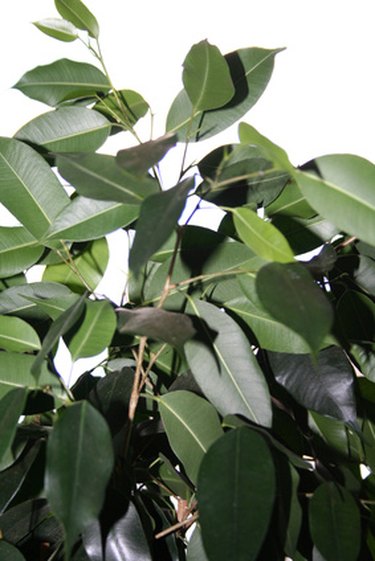
Known for their glossy evergreen foliage, rubber trees (Ficus elastica) serve well as houseplants and outdoor ornamentals in frost-free areas. Although they are large tree in the wild, rubber trees respond well to pruning and can be kept quite small if trimmed regularly. If properly cared for, few pests or diseases seriously threaten rubber trees; however, if weakened by overwatering or dark conditions they can be afflicted by several illnesses.
Southern Blight
Video of the Day
Caused by the fungus Sclerotium rolfsii, southern blight is an easily preventable moisture-related infection found in rubber trees during the summer months. Early symptoms include reddish or yellow spotting on the lower leaves, particularly on plants that are regularly misted or overwatered. As the infection progresses, masses of cottony fungi with hard brown lumps appear around the base of the stems and eventually spread up the stems and onto the leaves. Because southern blight is a devastating infection that is difficult to treat, prevention is the best option. Only sterilized potting medium should be used when repotting rubber trees, and water should be given sparingly during the growing season, taking care to keep the leaves dry.
Video of the Day
Crown Gall
Crown gall is a bacterial infection affecting the roots and stems of rubber trees, caused by a bacteria called Agrobacterium tumefaciens. Characterized by swollen areas along the stems, crown gall can cause large, disfiguring masses to appear, which are deadly to the plant. The roots can also be affected and are then inhibited from absorbing nutrients and moisture. Unfortunately, there is no treatment for crown gall, and any infected plants must be destroyed to prevent the spread of the bacterium.
Xanthomonas Leaf Spot
Xanthomonas leaf spot is one of the most common diseases found in rubber trees. Caused by a bacteria called Xanthomonas campestris, it is characterized by tiny oozing spots that appear on the leaves, eventually causing them to yellow and die. The spots rapidly grow in size and are often bordered by bright yellow discolorations that spread between the leaf veins. Copper-based bactericides can keep the infection from spreading if applied early, although they can harm healthy tissue if overused. Xanthomonas leaf spot can be prevented if excessive watering is avoided and fertilizer is used sparingly.
Thrips
Thrips are tiny winged insects known to attack rubber trees. Although some cultivars of rubber tree are resistant to thrip infestations, most commonly available ficus houseplants are susceptible to them. Early symptoms include silvery-gray scarring under the leaves where feeding has occurred, often causing infested leave to curl and drop. They can be prevented and controlled with commercially available insecticide.
Mealybugs
Mealybugs are white, waxy insects that sometimes colonize the undersides of rubber tree leaves. Early signs of a mealybug infestation include drooping or dry-looking leaves and the appearance of cotton-like masses along leaf attachment sites and on the undersides of the leaves. Manual removal of mealybugs is difficult and seldom effective, although spraying the affected area with an alcohol and water solution can lessen the severity of the infestation.